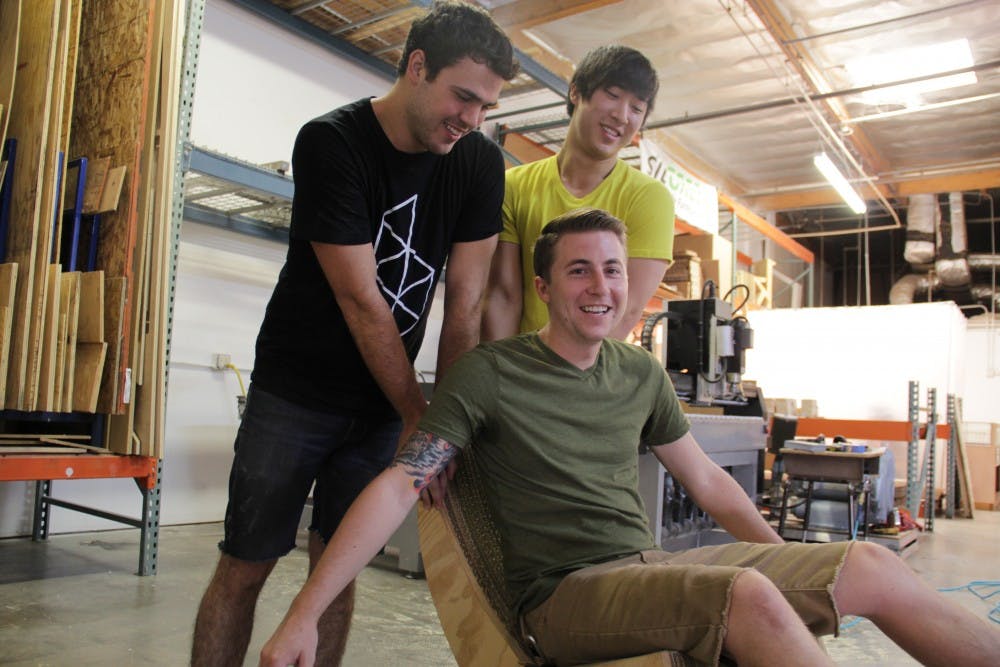 SITGREEN president and founder Jon Irons gets rocked by Jackson Minton, fabricator, and Alan Hsieh, product designer, in one of the company’s original furniture pieces. This piece was made with recycled cardboard. (Photo by Shawn Raymundo)
SITGREEN president and founder Jon Irons gets rocked by Jackson Minton, fabricator, and Alan Hsieh, product designer, in one of the company’s original furniture pieces. This piece was made with recycled cardboard. (Photo by Shawn Raymundo)The SITGREEN warehouse on Broadway Road serves as a sort of laboratory for unorthodox design experiments. Metal street signs are bent into seat backs and wooden chairs are bonded together to form Frankenstein-like creations.
Jon Irons, president and founder of SITGREEN, began renting the uniquely furnished warehouse space in June. Irons, who graduated from ASU in 2012, is not the typical furniture designer. SITGREEN rocking chairs, bike stands and end tables are all composed of tightly compressed cardboard.
The designs are intended to operate on a closed-loop cycle, using post-consumer cardboard to keep furniture waste out of landfills.
At 24 years old, Irons built SITGREEN from the ground up with help of Seed Spot, a nonprofit incubator for Arizona innovators and entrepreneurs whom the startup calls “localprenuers.” With the help of mentors and an advisory board, SITGREEN finally grew large enough to rent warehouse space and a CNC router, which is a computer-controlled shaping machine that cuts the cardboard furniture with more precision.
Irons designed his first cardboard chair for a sustainability project assigned in an interior design studio at ASU.
“I realized that when you saturate cardboard in glue, it basically becomes un-recyclable, just completely,” Irons said. "I kind of took that idea, and I added the wood sidings to it to get more rigidity and durability and then I added the metal hardware. Everyone thought it was really interesting.”
Irons said the earliest SITGREEN designs earned him pocket money while he was still a student.
“It was an outlet for me when I was in school, because there was no furniture design program at ASU,” Irons said.
During the first stages of the company, Irons completed a series of similar furniture designs, often renting the laser cutter in the Herberger digital lab for hours.
“I had boxes that I had cut down with an X-Acto Knife and I would strap them to some sort of weird cart and I would trolley it into the laser cutting area and pay wads of money to cut on the laser cutter,” Irons said.
One of Irons’ earliest designs, a sharply angled SITGREEN bench, sits on a stretch of sidewalk in front of Golden Rule Tattoo on Roosevelt.
"I mean, homeless people sleep on it. It's crazy," Irons said. “The cardboard’s held up better than the wood has, honestly, which is insane. It’s probably the best testament to the build structure." Irons said.
As for weight, the cardboard pieces trump wood furniture.
“If this was a solid piece of wood that went across, this would probably be three times as heavy,” Jackson Minton said, a 22-year-old SITGREEN fabricator.
Business grew quickly when Irons' venture launched from the Seed Spot program, which is evidenced by the growth of the SITGREEN team — adding on Minton and other 22-year-old designer, Allan Hsieh.
“When I realized that I needed to bring a designer on I called Allan, and luckily he had some free time," Irons said.
Hsieh, who began as a graphic design student at ASU, creates 3-D renderings of new SITGREEN products.
Irons says the SITGREEN team has streamlined the process of design and fabrication with the help of the CNC router.
“We really started rounding everything and doing a lot more organic forms.” Irons said. “Our competition legitimately is like IKEA ... because there aren’t enough cardboard furniture places or similar ones to us that we have any kind of competition.”
SITGREEN prices range from $15 for a 4-inch square pencil holder to a $1,000 bed base design called the “bed head.”
Irons said he would like to see the next generation of purpose-driven businesses grow with the help of Seed Spot.
“There’s a huge entrepreneurship community here that’s kind of growing,” Irons said. “Phoenix right now, it’s defining itself, and that’s kind of the cool thing that Seed Spot’s helping it do.
“From the very beginning, I had basically advisers and different people that were way older than me helping me through. And that’s the only reason I made it.”
Reach the reporter at aovnicek@asu.edu or follow her on Twitter @aovnicek




